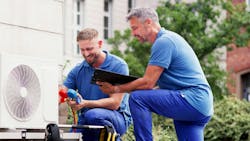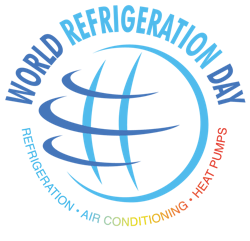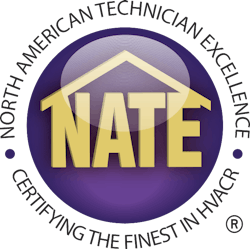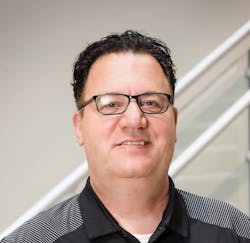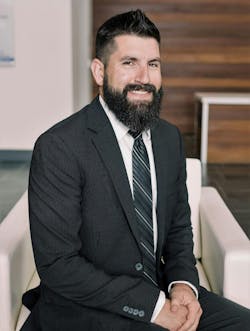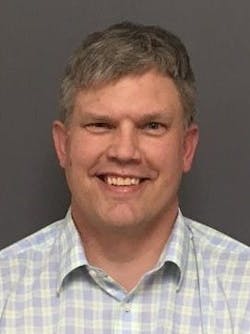Training HVACR Technicians for the A2L Transition
WORLD REFRIGERATION DAY is THURSDAY, JUNE 26. Heating, cooling and refrigeration technicians are on the front lines of following proper procedures at all times, and learning about the new, A2L refrigerants. North American Technician Excellence is here to help. -ed.
When the American Innovation and Manufacturing Act (AIM Act) passed in 2020, it started the gradual phase-down in the production and consumption of listed hydrofluorocarbons (HFCs). The alternative refrigerants being used, including A2Ls, have additional safety concerns such as flammability.
North American Technician Excellence (NATE) offers the Low-GWP (global warming potential) certification exam covering A2L refrigerants. Certification addresses these new safety concerns by ensuring technicians have the skills and job knowledge necessary to use these new refrigerants safely. NATE’s offering provides a strong emphasis on the safe handling and use of these new refrigerants.
To help technicians prepare for the Low-GWP transition, NATE offers a variety of training resources. Technicians can take advantage of NATE’s paperback study guides and online training platform, NATE Training Academy. For technicians that are looking for in-person training opportunities, they can take courses with NATE’s Recognized Training Providers (RTP).
NATE RTPs are organizations with established training courses that have worked with NATE to ensure their curriculum covers the Knowledge Areas of Technician Expertise (KATE) for the Low-GWP Refrigerant Certification Exam. Manufacturers, wholesalers and distributors, contractors, trade associations, and educational organizations from across the HVACR industry participate in NATE’s RTP program. By taking courses with training providers with NATE-recognized course content, technicians can ensure they are not only prepared to pass the Low-GWP Refrigerant Certification Exam but also ready to meet the evolving demands of the HVACR industry.
One of many supporters of NATE and its Low-GWP refrigerant certification program is Don Gillis, senior technical trainer, The Chemours Company, a NATE RTP. Gillis’s firm has begun taking orders from North American customers for its Opteon XL41 (R-454B) hydrofluoroolefin (HFO) refrigerant. The product is an R-410A replacement in new air conditioning and heat pump applications. It offers zero ozone depletion potential (ODP) and an approximate 78 percent reduction in GWP when compared to R-410A (AR4 GWP).
Gillis explains that NATE certification can help technicians as they prepare for the A2L refrigerant transition. “I love the NATE program, and all Chemours’ courses meet requirements as preparation to take NATE certification exams. NATE is a great resource for A2L training—and it is training I’ve taken. The courses are up to date with the latest information to help technicians make a smooth transition into A2L refrigerants.”
For the past several years, Gillis says that Chemours has been implementing a robust strategy to increase awareness of the importance of A2L training. His company has also helped support HVACR technicians gain access to resources they need to receive that A2L training. “Our instructional support runs the gamut, including everything from us hosting training webinars to cast a wide net as well as going onsite to train large or small groups of technicians.”
“NATE is very important to the industry, and NATE’s Low-GWP Refrigerants Certification Exam provides validation that a technician is proficient when it comes to explaining, designing, and working with Low-GWP refrigerants,” says Benjamin S. Middleton, national sales training manager at Daikin Comfort Technologies North America, Inc.
Middleton says Daikin offers training for HVACR technicians and others in preparation for the A2L refrigerant transition. Additionally, as a NATE RTP, Daikin has had its technician courses recognized by NATE. “We have live training options, virtual reality (VR) training, and prerecorded content geared towards technicians and Comfort Advisors.” Students in the Daikin A2L training initiative include business owners, sales professionals, installers, and service technicians.
Popular refrigerants that possess a much higher GWP, such as R-410A, R-22, and R-407C, are classified as A1 refrigerants, which mean they are identified as having “no flame propagation.” A2L refrigerants are slightly more flammable.
Popular refrigerants that possess a much higher GWP, such as R-410A, R-22, and R-407C, are classified as A1 refrigerants, which mean they are identified as having “no flame propagation.” A2L refrigerants are slightly more flammable.
NATE certification on A2L, Low-GWP refrigerants can provide benefits for technicians and end-users alike, says Lenny Diaddario, manager, contractor services at Copeland, a global provider of sustainable climate solutions, including Low-GWP refrigerant options. The company offers products in compression, controls, software, and monitoring for heating, cooling, and refrigeration.
Diaddario identifies two key benefits to certification:
1) It gives technicians the confidence, knowledge, and training they need to stay competitive and offer their A2L expertise.
2) It provides end-users with peace of mind knowing they have access to a qualified service network needed to make the transition to new refrigerant and system technologies.
Diaddario says Copeland offers a wealth of instruction on the refrigerant transition: “Our Educational Services team is conducting in-person and online A2L training seminars as part of its ‘Fit for the Future’ training initiative. Its objectives are to prepare service technicians with the fundamentals needed to safely install, service, and recover A2L refrigerants.”
The audience for Copeland training is broad, Diaddario explains: “Technicians are at the front lines of the refrigerant transition, so many contracting companies will send their teams for training. We also have retail end-user and original equipment manufacturer (OEM) customers enroll so they can familiarize themselves with the nuances of working with A2Ls.”
It's All About Training
There’s no shortage of training at Carrier, says Jim Price, technical training center manager, Carrier: “A2L competency is a critical component of a successful installation; therefore, we offer A2L- and R-454B-specific online training through our learning management system (LMS), My Learning Center. Additional R-454B training is integrated into our hands-on training offered at the My Learning Center Technical Training Center in Indianapolis, Indiana.”
The change process for refrigerants has been on-going, according to Price. “The new requirements for refrigerant transition,” he says, “are almost entirely rooted in proper refrigerant practices that have been in place for several decades.” Price’s take on certification? “NATE-certified technicians are often more familiar with industry regulations, best practices and, in turn, can provide homeowners peace of mind.”
Price says a variety of students take Carrier’s A2L refrigerants classes: “The industry transition impacts everyone in the field. Our students range from upcoming technicians to longtime HVACR tradesmen and women, to distributors looking to get a better understanding of what’s coming down the pipeline. We highly encourage everyone in our channel to participate in training in advance of 2025.”
Price notes that the Carrier training keeps learners aware of changes in the industry: “Our online courses are designed for students that need baseline knowledge of regulation and refrigerant standards; however, most students are technicians that are interested in ‘getting ahead of the curve.’” He adds, “Our students don’t want to be surprised by what they encounter in the field.”
Multiple training tools are in place, Price explains: “At Carrier, we have developed a variety of easily accessible resources to keep our technicians informed of the latest developments and regulations regarding A2L. From social media series to newsletters and e-communications, we are diligent about consistent communication as the industry shift nears. Our information sources help inform A2L training curriculums as we gather feedback and identify recurring questions not currently addressed in training.”
The HVACR industry needs to prepare technicians for changes coming to equipment and servicing, says Chris Rich, district service coordinator-GA at Dealers Supply Co. The firm is a wholesale distributor of heating, ventilating, and air conditioning equipment, supplies, and accessories. He notes, “I see in my classes that about half of the contractors are totally unaware of the changes brought on by the A2L refrigerant transition.”
Rich says he offers a comprehensive overview in his Dealers Supply classes. “I will start with an overview of the M-M1 (Minimum efficiency standard to M1 minimum efficiency standard) changes and then an overview of how and why we are changing to the new A2L refrigerants. Then, we cover myths and facts on the A2L refrigerants and proper install and service procedures. In addition, we discuss changes in equipment and tools. In the classes we cover safety thoroughly on working with the A2L refrigerants.” A wide cross-section of professionals attends Dealers Supply A2L classes. “The majority are contractors that are our customers. We are also educating our sales staff and warehouse counter sales teams,” Rich explains.
Regarding the transition, Rich observes that information on the safety concerns are being spread incorrectly. “I see that most professionals,” he says, “think that the new A2L refrigerants have a propane base and are highly flammable. We are having to correct all these misconceptions as much as actually teach the facts.”
A2L refrigerant training for technicians is especially important for today’s workforce, Rich believes. “This is due to the fact that the newer generation of service technicians is lacking in practical experience and skills. These skills include soldering, brazing, and torch use around these refrigerants. Proper instruction, therefore, becomes critical. It becomes very important to have training on using brazing equipment around a flammable refrigerant.”
On the subject of training the newer generation, Greg Creel, a training analyst at Alabama Power’s HVAC Training Center in Jasper, Alabama, offers this thought: “It’s a different world trying to teach some youngsters. Some of the folks coming out of high school don’t know how to read a tape measure. It’s a learning curve. We may have to adjust our teaching approach to adapt.”
The HVAC Training Center does a one-day review covering all aspects of Low GWP Refrigerant Safety-A2L Refrigerants. Creel says there is a mix of older and younger technicians who take the center’s review session. The center conducts a variety of classes, including NATE Review and Testing and sessions on the EPA Section 608 Review and Testing.
“We train at the highest level for our dealer base, to ensure the end-user is getting an informed technician (with current information) on their site to resolve their HVACR issues,” says Bruce O. Davis, technical support advisor at Koch Air, one of the oldest Carrier distributors in North America. The company provides residential and commercial HVACR equipment as well as parts and supplies from 11 locations across the Midwest.
Davis’s team currently conducts R-454B (Puron Advance, an A2L refrigerant) training to the Koch Air dealer base. “We want to make sure all service personnel are fully up to date with our industry standards,” Davis explains.
Davis believes all distributors and manufacturers are doing their part in getting the information out on the A2L refrigerant transition. He adds that the dealer base “has an obligation to the end-users (home owners) to make sure they have a well-trained staff that will be able to work confidently and safely with this new refrigerant in our industry.”
Technician Training Makes Good Business Sense
Greg Guse, director of engineering for Ritchie Engineering Co., has been involved in training in several ways. His firm is a worldwide supplier of U.S.-designed and manufactured tools and equipment with its Yellow Jacket brand.
“Ritchie works with their reps to help train wherever we can,” says Guse. “Personally, I have been on several podcasts discussing our tools and helping people understand the hazards of A2Ls and A3s (higher flammability) as well as how to approach a safe system.” Guse has also been a presenter for two years at the HVAC Excellence training program, where he helps train the instructors and educate them on the changes coming with A2L’s and A3 refrigerants.
Guse offers the following advice to HVACR contractors who are considering investing in A2L refrigerant transition training for their technicians: “Absolutely spend the time and money now for training. Smarter, safer workers pay for themselves in less downtime and higher safety levels for all involved in your business. It just makes business sense!”
Trane and American Standard both provide training for HVACR technicians in preparation for the A2L refrigerant transition, says Eric Weiss, technical trainer, Trane Technologies Residential Solutions. “Our dealers and technicians have access to our one-hour eLearning course, or they can attend live training that is delivered by the local factory tech representatives. We have approximately 220 across the U.S. and Canada.”
The transition to A2L refrigerants provides the opportunity to discuss safe handling refrigerant practices in general. Weiss offers one safe practice example: “Technicians should always cut out refrigerant components rather than unbraze; this practice applies to all refrigerants--not just A2Ls.”
Weiss offers this advice to HVACR contractors and others in the building comfort industry that are considering investing in A2L refrigerant training for their technicians: “Realize that whatever training they attended is likely to change a little over the next few years. Continue to attend training, review updates in the manufacturers’ literature, and be ready to manage these small changes.”
For More Information
To learn more about NATE’s A2L certification, Low-GWP Refrigerants study guide, and online NATE Training Academy courses, visit: www.NATEX.org/LowGWP
For more information about some of NATE’s Recognized Training Provider A2L training programs, check out the sites below:
For locations near you: https://natex.org/locate-a-training-organization
The Chemours Company: https://www.opteon.com/en/; https://www.opteon.com/en/support/training.
Daikin Comfort Technologies North America: www.HVACLEarningCampus.com
Carrier: MLCtraining.com
In addition, the Air Conditioning Contractors of America (ACCA) offers A2L refrigerant safety training. The course is designed for individuals who are already certified as EPA Section 608 Universal Technicians, or have a good understanding of the refrigeration cycle, refrigerant applications/blends, recovery equipment/procedures, and cylinder safety. Based on the ASHRAE Standards 15 (2019), 15.2 (2022), and 34 (2019) and UL Safety Standards 60335-2-40 (2019), and 60335-2-89 (2019), it’s available in English and Spanish; the training is free for ACCA members and offered as a value to non-members. Visit https://www.acca.org/education/a2ltraining.
Michael Keating is a contributor to the NATE Magazine.
For More Information
To learn more about NATE’s A2L certification, Low-GWP Refrigerants study guide, and online NATE Training Academy courses, visit: www.NATEX.org/LowGWP
For more information about some of NATE’s Recognized Training Provider A2L training programs, check out the sites below:
For locations near you: https://natex.org/locate-a-training-organization
The Chemours Company: https://www.opteon.com/en/; https://www.opteon.com/en/support/training.
Daikin Comfort Technologies North America: www.HVACLEarningCampus.com
Carrier: MLCtraining.com
In addition, the Air Conditioning Contractors of America (ACCA) offers A2L refrigerant safety training. The course is designed for individuals who are already certified as EPA Section 608 Universal Technicians, or have a good understanding of the refrigeration cycle, refrigerant applications/blends, recovery equipment/procedures, and cylinder safety. Based on the ASHRAE Standards 15 (2019), 15.2 (2022), and 34 (2019) and UL Safety Standards 60335-2-40 (2019), and 60335-2-89 (2019), it’s available in English and Spanish; the training is free for ACCA members and offered as a value to non-members. Visit https://www.acca.org/education/a2ltraining.
About the Author
Michael Keating
Michael Keating is a freelance writer specializing in industrial and technology-related topics and trends.
